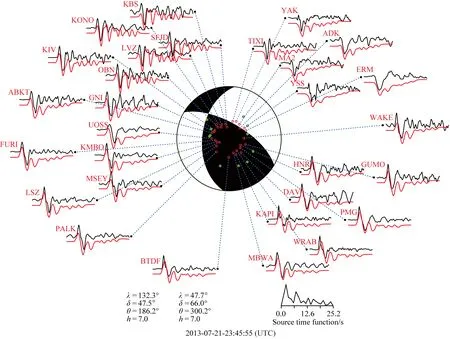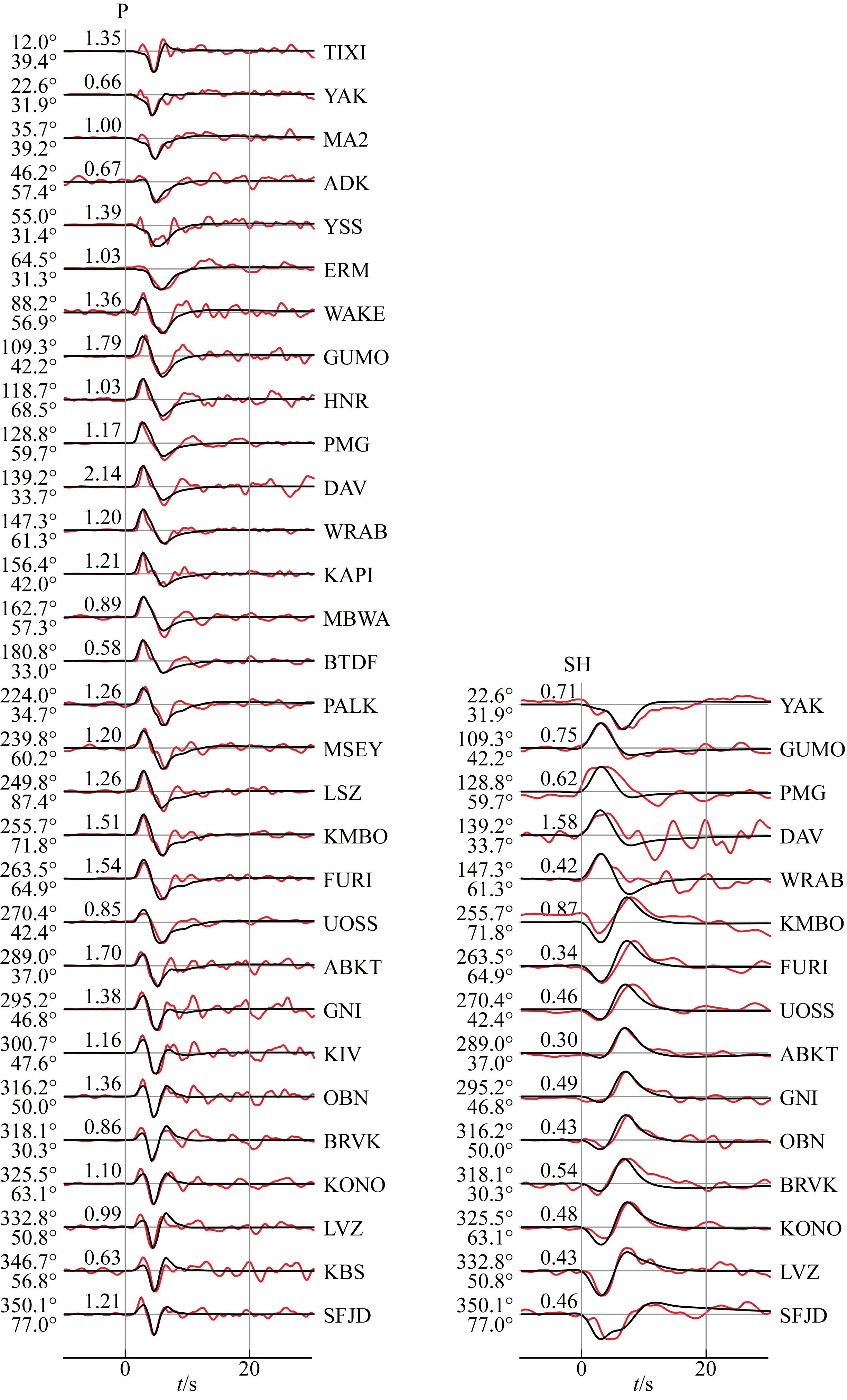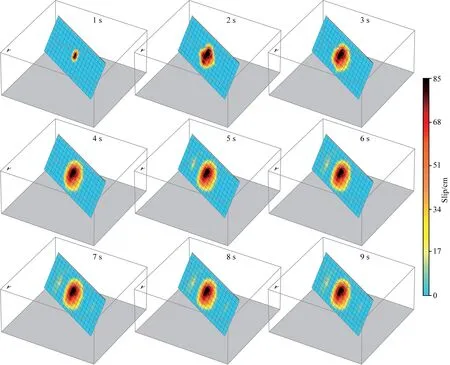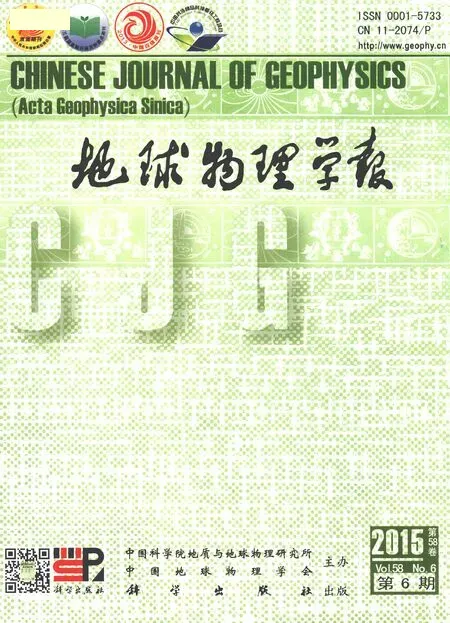2013年7月22日甘肃岷县—漳县MS6.6地震震源破裂过程
孙蒙, 王卫民, 王洵, 何建坤
大陆碰撞与高原隆升重点实验室,中国科学院青藏高原研究所, 北京 100101
2013年7月22日甘肃岷县—漳县MS6.6地震震源破裂过程
孙蒙, 王卫民*, 王洵, 何建坤
大陆碰撞与高原隆升重点实验室,中国科学院青藏高原研究所, 北京 100101
2013年7月22日,在甘肃岷县漳县交界处发生MS6.6地震,地震震中位置靠近临潭—宕昌断裂.本文通过构建有限断层模型,利用国家强震动台网中心提供的12条强地面运动三分量资料,通过波形反演方法来研究这次地震的震源破裂过程.结果显示这次地震是发生在甘东南地区岷县—宕昌断裂带东段附近的一次MW6.1级逆冲兼具左旋走滑破裂事件,最大滑动量约为80 cm.发震断层走向及滑动性质与岷县—宕昌断裂吻合,推断本次地震与东昆仑断裂向北的扩展和推挤密切相关,是岷县—宕昌断裂进一步活动的结果.
岷县—漳县地震; 强地面运动; 模拟退火方法; 震源破裂过程
1 引言
北京时间2013年7月22日7时45分,甘肃定西市岷县与漳县交界处发生MS6.6地震.地震造成95人死亡,1366人受伤,七十余万人受灾,并引发了滑坡、崩塌和塌陷等多种次生灾害,造成了一定程度的人员和经济损失.
地震发生区域属于青藏高原东北部的甘东南地区,是中国构造分区中南北与东西构造分区的交汇位置(郑文俊等,2013).这一地区历史上地震活动比较频繁(贾科和周仕勇,2012),强震有842年碌曲6~7级地震(顾功叙等,1983;国家地震局兰州地震研究所,1989),1573年岷县6级(郑文俊等,2007a)和1837年岷县北6级地震(郑文俊等,2007b)等;本次地震前,这一地区发生了2003年11月13日岷县5.2级地震(李亚荣等,2006)和2004年9月7日岷县—卓尼5.0级地震.如图1所示,本次地震震中位于两条区域性断裂西秦岭北缘断裂和临潭—宕昌断裂中间,靠近临潭—宕昌断裂.由于青藏高原的北东向挤压,甘东南地区成为从东昆仑断裂向西秦岭北缘断裂逐渐转换过渡的复杂结构,在东昆仑断裂和西秦岭北缘断裂之间存在很多以逆冲为主兼具左旋走滑分量的断裂来实现其构造转换.临潭—宕昌断裂就是其中的一条,临潭—宕昌断裂带由几条次级断裂组成,断裂的总体性质是以向南逆冲为主,兼具左旋走滑分量.临潭—宕昌断裂带各断裂段活动性差异较为明显,且每段内也呈现出断裂活动的不均匀性.此次地震发生在靠近临潭—宕昌断裂东段的区域(何文贵等,2013).
地震发生以后,很多学者对其震源机制解、主震及余震重定位以及地震孕育机制等进行了研究.陈继锋等(2013)反演了本次地震的矩张量解,并对其可能的发震断层进行了探讨;冯红武等(2013)对主震及其余震进行了重定位;葛伟鹏(2013)通过对跨震源区的P波Q值深度剖面分析,认为此地区有存在“下地壳流动”变形的可能性.
本文利用国家强震动台网中心提供的强地面运动三分量记录反演本次地震的滑动分布和破裂传播过程,并用国际地震学联合会(IRIS)地震数据中心提供的远场P波、SH波波形记录约束和检验用强地面运动反演得到的震源参数.强地面运动资料可提供较高的空间分辨率,但资料的公开和获取需要较长时间,而且很多情况下没有这方面的资料可用.本次甘肃岷县地震由于有较好的地震资料的支持,可以对其破裂过程有较为深入的研究,研究结果可以为该地区地质构造和发震断层情况等提供更深入的认识.同时,我们用远场实际观测地震资料来约束强地面运动资料反演得到的结果,从而确定本次地震断层面上的震源参数及地震破裂过程.
2 资料和研究方法
地震发生以后,许多研究机构和学者给出了2013年7月22日甘肃岷县6.6级地震的震源参数(见表1).对比不同定位结果得到的波形拟合效果后,本文采用中国地震局地球物理研究所的定位结果(34.54°N,104.189°E)作为震源位置.

图1 甘东南地区的地质构造图黑色震源球为本次地震发生前十年内所发地震的震源机制解,红色震源球为本次甘肃岷县—漳县地震的震源机制解;红色等值线所围成的区域为中国地震局公布的本次地震的烈度分布情况;绿色箭头为区域应力的方向;黑色三角形为本文所用强震台站.Fig.1 Geological condition map of the east-south of Gansu Black focal spheres are the focal mechanism of earthquakes occurred in the last 10 years before 2013 MS6.6 Minxian-Zhangxian earthquake, red focal sphere is the focal mechanism of the Minxian-Zhangxian MS6.6 earthquake; the red area is the seismic intensity distribution of this earthquake; green arrows stand for the regional stress; black triangles are the near-source stations.

机构节理面I节理面Ⅱ走向/(°)倾角/(°)滑动角/(°)走向/(°)倾角/(°)滑动角/(°)震源深度/km地震距IGPCEA1)180471203205162206.1IGCEA2)188.458.8142301.357.33866.47gCMT3)19657151303663717.16.0USGS4)177601083243462155.9Gssb5)19554149305654013.56.0本文186.247.5132.3300.26647.776.1
注:1)中国地震局地球物理研究所(IGPCEA,http://www.cea-igp.ac.cn/tpxw/267408.shtml);2)中国地震局地质研究所(IGCEA,http://www.eq-igl.ac.cn/admin/upload/files/20130722Dingxi.pdf);3)Global CMT webpage(http://www.globalcmt.org/CMTsearch.html);4)USGS NEIC(http://www.isc.ac.uk/iscbulletin/search/catalogue/);5)中国地震局兰州地震研究所(陈继锋等,2013).

图2 岷县—漳县MS6.6地震震源机制解采用下半球投影,同时给出了点源模型的P波垂向位移理论图(红线)与资料(黑线)的拟合情况.图形下方给出了两组节面解(左下,λ,δ,θ,h分别表示错动倾角、节面倾角、节面走向、震源深度)和点源模型的震源时间函数(右下).Fig.2 Focal mechanism of the Minxian-Zhangxian MS6.6 earthquake Lower-hemisphere projection is used here. The observed P wave records (black line) and the synthetic seismogram (red line) based on the simple point model are compared. The parameters of two possible fault planes are listed also, with λ, δ, θ, h indicating the rake angle, dip angle, strike direction and source depth respectively, the obtained source time function are plotted.
本文选取了国家强震动台网中心提供的12条强地面运动三分量记录(Hartzell and Heaton, 1983)并对数据进行预处理,即将加速度记录进行一次积分并进行带通滤波(频段0.02~0.4 Hz),获得去除高频成分的速度记录用于反演计算.数据预处理后,根据地质资料和震源机制解构建有限断层模型(姚振兴和纪晨,1997),反演发震断层面上的滑动分布.对于有限断层的破裂过程反演,发震断层的走向、倾向和滑动角是需要提前给定的.本文利用IRIS提供的12条近场P波波形记录的初动作为极性约束,利用30条远场地震记录进行点源反演求得其震源机制解,如图2所示.由表1可见,不同机构和学者得到的本次地震震源机制解两个节面的走向、倾角和滑动角相差不大,但深度相差比较大,震源机制解表明岷县漳县地震的断层活动具有逆冲兼具左旋走滑的性质.其中走向为300.2°的节面Ⅱ与区域内已知断层的走向一致(图1),且将节面Ⅱ假设为实际破裂面时反演得到的波形拟合效果比节面I假设为实际破裂面时更佳,故本文认为走向为300.2°的节面Ⅱ为实际破裂面.通过测试震源深度变化对波形拟合度的影响,发现震源深度在6~10 km时波形拟合度明显优于深度大于10 km的情况.综合各机构及本文的研究结果,我们取7 km为本次地震的震源深度.采用快速地震破裂持续时间测定方法(Lomax et al., 2007),利用获得的远场波形记录估算出岷县地震主震震源时间过程的持续时间,结果显示这次地震事件的断层破裂持续时间约为8 s.
3 有限断层破裂过程模型
3.1 有限断层震源模型的构建
本文构造了一个长(沿走向)为34 km,宽(沿倾向)为14.4 km的矩形平面来模拟岷县地震的发震断层,为详细描述发震断层各个位置的滑动情况,我们将该有限断层剖分为2 km×1.6 km的153(17×9)个子断层.经矫正各子面元相应的时间延迟后,叠加每个子面元的理论地震图,从而获得有限断层的理论地震图.利用强地面震动的实际观测记录,进行波形反演得到每个子面元的震源参数(包括上升时间τ、错矩D、滑动角λ和破裂传播速度v),进而获得本次地震的破裂传播过程.其中震源时间函数采用的是开始和结束时间各不相同的非对称余弦函数(Ji et al., 2003).
3.2 反演结果
我们利用频率波数域法(Zhu and Rivera, 2002; 纪晨和姚振兴,1995)计算近场的格林函数,用模拟退火方法(王卫民等,2005a)在时间域进行破裂过程反演(王卫民等,2005a,2005b).速度模型采用的是王周元等(1996)对甘肃地区速度结构非均匀分布的研究结果.反演中,将滑动振幅限定于0.0~100.0 cm之间;滑动角限定于40°~120°之间;破裂传播速度限定于2.1~2.9 km·s-1之间.此外,利用断层面各子面元滑动量的微分平均值,作为模型光滑约束.同时,我们利用近场得到的震源参数计算远场理论地震图,与远场实际观测资料对比来验证模型的正确性和约束地震矩M0,从而确定了本次地震的滑动分布和破裂过程.
结果模型的理论地震图与实际观测三分量记录拟合情况如图3所示.由图可以看到,基于单平面有限断层震源模型计算得到的理论位移与观测资料能较好地吻合.由反演得到的断层面上的滑动分布情况(图4)看出,本次地震的断层面上的破裂比较集中,地表没有发生破裂,破裂主要集中在震源附近,最大滑动量约为80 cm.其中震源东南侧破裂程度大,北西侧破裂程度较小,滑动性质为逆冲,兼具左旋走滑.图5为发震断层滑动分布地表投影示意图.图6为反演得到的震源参数模型正演计算远场理论地震图和实际观测资料的对比.由该图可以看到,远场理论地震图和实际观测波形可以比较好地拟合,从而进一步验证近场反演结果的可靠性和合理性.
3.3 地震震源破裂过程
根据单平面有限断层震源模型的反演结果,得到岷县地震的标量地震矩M0=1.60×1025dyn·cm,计算相应的矩震级为MW6.1(Kanamori,1977).
图7为本次地震断层面上不同时刻的滑动分布示意图.从破裂过程来看,地震在前2 s的破裂传播速度很快,破裂主要沿断层面倾向向浅部传播.2 s时,震源附近东南侧发生集中的高破裂滑动,平均滑动量约为60 cm. 4 s时,震源附近的破裂程度已基本固定,最大滑动量约为80 cm.5 s开始,断层面两侧开始发生轻微破裂.8 s以后整个断层面的破裂基本结束.

图3 有限断层模型的强地面运动资料拟合强地面运动三分量理论速度(红线)与实际观测波形资料(黑线)的拟合情况,每条记录的左上表示台站名,左下分别表示震中距和方位角,右表示振幅比.Fig.3 Comparison of the observed near field strong motion records with the synthetic waveforms Comparison of observed (black) and synthetic waveforms (red) for strong motion records are shown in the panel, the azimuth, epicentral distance, amplitude ratio and station name are also indicated.

图4 利用强地面运动三分量资料反演得到的地震断层面上的滑动分布图中分别给出了有限断层模型的地表投影(左上)和三维示意图(右上).Fig.4 Slip distribution on the fault invert using near field strong motion three component records Surface projection of fault model (up-left) and 3D view of the fault model (up-right) are shown.

图6 强地面运动资料反演结果计算得到的远场理论位移图与实测位移图对比P波垂向和SH波切向实测位移图(红线)与理论位移图(黑线)的对比,并给出每个记录的方位角(左上)、震中距(左下)、振幅比(上)和台站名(右).Fig.6 Comparison of the observed records with the synthetic waveforms calculated by using source parameters inversed by near field strong motion records Comparison of observed (red) and synthetic waveforms (black) for P vertical components, and SH components are shown in the panel, the azimuth, epicentral distance, amplitude ratio and station name are also indicated.

图7 岷县—漳县MS6.6地震震源破裂过程Fig.7 Rupture process of MS6.6 Minxian-Zhangxian earthquake
4 讨论
本次地震发生在中强地震频发的甘东南地区构造过渡转换带上,来自青藏块体东北向的挤压力在该区域的重分配比较复杂(卜玉菲等,2013),震中位置靠近临潭—宕昌断裂.临潭—宕昌断裂带由多条规模不等的次级断裂组成,不同断裂带上的应力分布不均匀,是这一地区中强地震频发的一个原因.该断裂带的形成受到早期西秦岭北缘断裂向两侧的扩展和如今青藏高原东北部东昆仑断裂向北扩展和推挤及向东运动的影响.本次地震发震断层的走向以及余震空间分布与临潭—宕昌断裂的走向吻合,倾向、倾角等也与临潭—宕昌断裂带东段的总体性质相似(葛伟鹏,2013;郑文俊等,2013),因此推断此次地震是临潭—宕昌断裂进一步活动的结果.本次MS6.6岷县漳县地震发震断层面上的滑动性质为逆冲兼具左旋走滑,这与该区域其他已存在断层的性质一致.GPS资料(Liang et al., 2013)显示,本次地震震中附近的地壳运动水平方向为正东,垂直方向向上.将GPS测得的地壳运动速度矢量投影到发震断层面后可看到震源区地壳运动方向与本文反演得到的断层面上逆冲兼具左旋走滑的滑动性质相符合.
本次地震震源过程的研究结果可以为进一步探讨临潭—宕昌断裂带各次级断裂的活动性差异和区域应力的分配提供良好的基础.临潭—宕昌断裂作为东昆仑断裂与西秦岭北缘断裂走滑速率不一致而形成的过渡转换带中的一条,它的活动性研究对于青藏高原东缘及东北缘变形和构造演化等科学问题有重要意义.
2013年7月22日甘肃岷县漳县MS6.6地震的发震位置——甘东南地区处于青藏高原东北缘.近年来,青藏高原东缘发生了2008年MS8.0汶川地震、2013年MW6.7芦山地震两次强震.有学者(万永革等,2009)通过分析汶川地震后周边库仑应力变化,认为甘东南地区的库仑应力具有正变化趋势,推测这次岷县漳县地震可能受到汶川地震同震及震后变形的影响.本文获得的这次地震震源过程研究结果可为这一地震触发问题提供更有力的数据基础.
致谢 本文所用宽频带地震记录由IRIS下载.强地面运动三分量资料由中国地震局工程力学研究所国家强震动台网中心提供.
Bu Y F, Zhang Y S, Wan Y G, et al. 2013. The tectonic stress field in southeastern area of Gansu province deduced from P wave polarity data.ChinaEarthquakeEngineeringJournal(in Chinese), 35(1): 160-165.
Chen J F, Lin X D, He X S. 2013. Moment tensor inversion and seismogenic tectonics of the 2013 MinxianMS6.6 earthquake in Gansu.ChinaEarthquakeEngineeringJournal(in Chinese), 35(3): 425-431.China Seismological Bureau of Lanzhou Institute of Earthquake. 1989. Collection of Gansu Earthquake Datum (in Chinese). Beijing: Seismological Press.
Feng H W, Zhang Y S, Liu X Z, et al. 2013. Relocation of mainshock and aftershocks of the 2013 Minxian-ZhangxianMS6.6 earthquake in Gansu.ChinaEarthquakeEngineeringJournal(in Chinese), 35(3): 443-447.
Ge W P. 2013. Discussion on the relationship between regional landform and seismogenic structure of the Minxian-ZhangxianMS6.6 earthquake. 2013.ChinaEarthquakeEngineeringJournal(in Chinese), 35(4): 840-847.
Gu G X, Lin T H, Shi Z L, et al. 1983. Catalogue of Chinese Earthquakes (1831 BC to 1969 AD). Beijing: Seismological Press.
Hartzell S H, Heaton T H. 1983. Inversion of strong ground motion and teleseismic waveform data for the fault rupture history of the 1979 Imperial Valley, California, earthquake.BulletinoftheSeismologicalSocietyofAmerica, 73(6A): 1553-1583.
He W G, Zhang W J, Wang A G, et al. 2013. New activities of Lintan-Dangchang fault and its relations to Minxian-ZhangxianMS6.6 earthquake.ChinaEarthquakeEngineeringJournal(in Chinese), 35(4): 751-760.
Ji C, Yao Z X. 1995. The study of the method for broadband regional synthetic seismogram.ChineseJ.Geophys. (ActaGeophysicaSinica) (in Chinese), 1995, 38(4): 460-468.Ji C, Helmberger D V, Wald D J, et al. 2003. Slip history and dynamic implications of the 1999 Chi-Chi, Taiwan, earthquake.JournalofGeophysicalResearchB:SolidEarth, 108(B9): ESE5-1-ESE5-16.Jia K, Zhou S Y. 2012. Inference of source parameters of historical major earthquakes from 1900 to 1970 in southwestern China and analysis of their uncertainties.ChineseJ.Geophys. (in Chinese), 55(9): 2948-2962, doi: 10.6038/j.issn.0001-5733.2012.09.014.
Jia K, Zhou S Y, Wang R. 2012. Stress interactions within the strong earthquake sequence from 2001 to 2010 in the Bayankala Block of Eastern Tibet.BulletinoftheSeismologicalSocietyofAmerica, 102(5): 2157-2164.Kanamori H. 1977. The energy release in great earthquakes.JournalofGeophysicalResearch, 82(20): 2891-2897.
Li Y R, Rong D L, Liu X Z, et al. 2006. The moment tensor inversion of the source mechanism of Minxian earthquake (ML5.5, Nov. 13, 2003).SouthChinaJournalofSeismology(in Chinese), 26(1): 126-132.Liang S M, Gan W J, Shen C Z, et al. 2013. Three-dimensional velocity field of present-day crustal motion of the Tibetan Plateau derived from GPS measurements.JournalofGeophysicalResearch, 118(10): 5722-5732.Lomax A, Michelini A, Piatanesi A. 2007. An energy-duration procedure for rapid determination of earthquake magnitude and tsunamigenic potential.Geophys.J.Int., 170(3): 1195-1209.Wan Y G, Shen Z K, Sheng S Z, et al. 2009. The influence of 2008 Wenchuan earthquake on surrounding faults.ActaSeismologicaSinica(in Chinese), 31(2): 128-139.Wang W M, Li L, Zhao L F, et al. 2005a. Rupture process of Jiashi, Xinjiang earthquake (MS6.5) of Feb. 24, 2003.ChineseJ.Geophys. (in Chinese), 48(2): 343-351, doi: 10.3321/j.issn:0001-5733.2005.02.016.
Wang W M, Zhao L F, Li J, et al. 2005b. Rupture process of the Chi-Chi (Taiwan) earthquake in 1999.ChineseJ.Geophys. (in Chinese), 48(1): 132-147, doi: 10.3321/j.issn:0001-5733.2005.01.019.
Wang Z Y, Fan S H, Ji F Y, et al. 1996. The inhomogeneity of crustal velocity in Gansu region.NorthwesternSeismologicalJournal(in Chinese), 18(2): 18-25.
Yao Z X, Ji C. 1997. The inverse problem of finite fault study in time domain.ChineseJ.Geophys. (ActaGeophysicaSinica) (in Chinese), 40(5): 691-701.
Zheng W J, Lei Z S, Yuan D Y, et al. 2007a. Textual research on the historical data of the 1573 AD Minxian earthquake in Gansu province and discussion on its seismogenic structure.EarthquakeResearchinChina(in Chinese), 23(1): 75-83.
Zheng W J, Lei Z S, Yuan D Y, et al. 2007b. Structure research on the 1873 northern MinxianM6 earthquake in Gansu province and its causative structure.Earthquake(in Chinese), 27(1): 120-130.
Zheng W J, Yuan D Y, He W G, et al. 2013. Geometric pattern and active tectonics in Southeastern Gansu province: Discussion on seismogenic mechanism of the Minxian-ZhangxianMS6.6 earthquake on July 22, 2013.ChineseJ.Geophys. (in Chinese), 56(12): 4058-4071, doi: 10.6038/cjg20131211.
Zhu L P, Rivera L A. 2002. A note on the dynamic and static displacements from a point source in multilayered media.Geophys.J.Int., 148(3): 619-627.
附中文参考文献
卜玉菲, 张元生, 万永革等. 2013. P波极性揭示的甘东南地区构造应力场特征. 地震工程学报, 35(1): 160-165.
陈继锋, 林向东, 何新社. 2013. 2013年甘肃岷县MS6.6地震矩张量反演及发震构造初探. 地震工程学报, 35(3): 425-431.
冯红武, 张元生, 刘旭宙等. 2013. 2013年甘肃岷县漳县MS6.6地震及其余震序列重定位. 地震工程学报, 35(3): 443-447.
葛伟鹏. 2013. 岷县漳县6.6级地震发震构造与区域地形地貌特征关系讨论. 地震工程学报, 35(4): 840-847.
顾功叙, 林庭煌, 时振梁等. 1983. 中国地震目录(公元前1831年—公元1969年). 北京: 地震出版社.
国家地震局兰州地震研究所. 1989. 甘肃地震资料汇编. 北京: 地震出版社.
何文贵, 郑文俊, 王爱国等. 2013. 临潭—宕昌断裂新活动特征与岷县漳县MS6.6地震关系研究. 地震工程学报, 35(4): 751-760.
纪晨, 姚振兴. 1995. 区域地震范围的宽频带理论地震图算法研究. 地球物理学报, 38(4): 460-468.
贾科, 周仕勇. 2012. 西南地区1900—1970年历史地震震源参数推断及结果的不确定性分析. 地球物理学报, 55(9): 2948-2962, doi: 10.6038/j.issn.0001-5733.2012.09.014.
李亚荣, 荣代潞, 刘旭宙等. 2006. 2003年11月13日岷县ML5.5级地震震源机制的矩张量反演. 华南地震, 26(1): 126-132.
万永革, 沈正康, 盛书中等. 2009. 2008年汶川大地震对周围断层的影响. 地震学报, 31(2): 128-139. 王卫民, 李丽, 赵连锋等. 2005a. 2003年2月24日新疆伽师MS6.5级地震震源破裂过程研究. 地球物理学报, 48(2): 343-351, doi: 10.3321/j.issn:0001-5733.2005.02.016.
王卫民, 赵连锋, 李娟等. 2005b. 1999年台湾集集地震震源破裂过程. 地球物理学报, 48(1): 132-147, doi: 10.3321/j.issn:0001-5733.2005.01.019.
王周元, 范世宏, 姬凤英等. 1996. 甘肃地区地壳速度的非均匀分布. 西北地震学报, 18(2): 18-25.
姚振兴, 纪晨. 1997. 时间域内有限地震断层的反演问题. 地球物理学报, 40(5): 691-701.
郑文俊, 雷中生, 袁道阳等. 2007a. 1573年甘肃岷县地震史料考证与发震构造探讨. 中国地震, 23(1): 75-83.
郑文俊, 雷中生, 袁道阳等. 2007b. 1837年甘肃岷县北6级地震考证与发震构造分析. 地震, 27(1): 120-130.
郑文俊, 袁道阳, 何文贵等. 2013. 甘肃东南地区构造活动与2013年岷县—漳县MS6.6级地震孕震机制. 地球物理学报, 56(12): 4058-407, doi: 10.6038/cjg20131211.
(本文编辑 何燕)
Rupture process of the Minxian-Zhangxian, Gansu,ChinaMS6.6 earthquake on 22 July 2013
SUN Meng, WANG Wei-Min*, WANG Xun, HE Jian-Kun
KeyLaboratoryofContinentalCollisionandPlateauUplift(LCPU),InstituteofTibetanResearch,ChineseAcademyofSciences,Beijing100101,China
On July 22, 2013, a major earthquake (MS6.6) occurred on the boundary of Minxian and Zhangxian in Gansu province, with its epicenter near the Lintan-Dangchang fault. Based on the finite fault model constructed, the rupturing process of this earthquake was determined by the waveform method using 12 near source strong motion three-component records provided by China Earthquake Data Center.Strike, dip angle, and rake angle of seismogenic fault as well as focal depth are supposed to be known before the waveform inversion based on a finite fault model. The focal mechanism of the earthquake is obtained by a dislocation source model utilizing 30 far-field P vertical waveform records with uniform azimuth coverage and 12 near-field P-wave initial motions. Geometric parameters of the seismogenic fault plane and focal depth adopted in the inversion were determined by considering information such as results of different institutions and scholars, waveform fitting obtained by treating two nodal planes as fault planes, and strike of existing faults in this area. The strike is 300.2°, dip angle is 66°, slip angle is 47.7°, focal depth is 7 km. In the process of inverting rupture process of this earthquake using strong motion records, Green′s function was calculated byf-kintegration and source parameters over the fault,including slip amount, slip rake, rise time and rupture velocity,which were inverted by simulated annealing method. In order to check the accuracy of source parameters deduced by strong motion records, we use the deduced source parameters to calculate the far-field synthetic waveforms and then compare them with observed ones.Results show that slip over the seismogenic fault is centralized nearby the focal source, maximum slip is around 80 cm, and no slip on the surface of ground. This earthquake is dominated by over-thrust with sinistral strike-slip component, consistent with other faults in this area. The rupturing ended at 8 s. Seismic momentM0is 1.60×1025dyn·cm, moment magnitudeMWis 6.1.Considering the strike of the seismogenic fault and aftershocks′ distribution matches with Lintan-Dangchang fault, rake and dip of seismogenic fault are also similar to those of eastern part of Lintan-Dangchang fault, we deduce this earthquake was related with the north forward extrusion of the east Kunlun fault and resulted from the further activity of the Minxian-Dangchang fault.
Minxian-Zhangxian earthquake; Strong ground motion; Simulated annealing method; Rupture process
10.6038/cjg20150607.
国家自然科学基金项目 (41174037)资助.
孙蒙,女,1991年生,在读硕士生,从事地震震源过程研究. E-mail: sunmeng@itpcas.ac.cn
*通讯作者 王卫民,男,1971年生,副研究员,从事地震学研究. E-mail: wangwm@itpcas.ac.cn
10.6038/cjg20150607
P315
2014-10-30,2015-06-07收修定稿
孙蒙, 王卫民, 王洵等. 2015. 2013年7月22日甘肃岷县—漳县MS6.6地震震源破裂过程.地球物理学报,58(6):1909-1918,
Sun M, Wang W M, Wang X, et al. 2015. Rupture process of the Minxian-Zhangxian, Gansu,ChinaMS6.6 earthquake on 22 July 2013.ChineseJ.Geophys. (in Chinese),58(6):1909-1918,doi:10.6038/cjg20150607.
——以盈江地区为例

